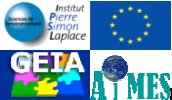 |
GEIA-ACCENT emission data portal |  |
| Project |
| Emission Data portal |
| Data manipulation tools |
| ECCAD |
| Workshops & meetings |
| Contacts |
| Web links |
| ACCENT web portal |
| GEIA project |
| Other Web links |
NatAir http://natair.ier.uni-stuttgart.de/
NatAir is dedicated to improving and applying methods for the calculation of natural and biogenic emissions and assessment of impacts on air quality. NatAir could be used to evaluate existing natural emission databases.
AIMES http://www.aimes.ucar.edu/contacts.shtml
AIMES is the Earth System synthesis and integration project of the International Geosphere-Biosphere Programme (IGBP). The challenge for AIMES is to achieve a deeper and more quantitative understanding of the role of human perturbations to the Earth's biogeochemical cycles and their interactions with the coupled physical climate system. GEIA is part of AIMES.
ATLAS has a goal of providing global datasets including all of the information needed for developing assessments (eg, GDP, population, etc). ATLAS is part of AIMES.
SOLAS http://www.igbp.net/page.php?pid=188
SOLAS deals with the surface ocean-lower atmosphere interactions aspects of the IGBP. SOLAS has created a framework for bringing together data associated with individual projects. SOLAS is an important resource for providing carefully reviewed ocean emissions data.
IGAC http://www.igac.noaa.gov/
IGAC, the International Global Atmospheric Chemistry, is part of IGBP.
iLEAPS http://www.atm.helsinki.fi/ILEAPS/
iLEAPS is the integrated land ecosystem atmosphere processes study which like SOLAS is part of IGBP. These data could feed into GEIA, helping to provide information on fluxes between terrestrial ecosystems and the atmosphere. iLEAPS is an important resource for providing carefully reviewed terrestrial emissions data.
ACCENT European Network http://www.accent-network.org/
There are several activities and projects in ACCENT where interaction with GEIA is important, including, for example, the model intercomparisons, biosphere-atmosphere exchange, transport and transformation, satellite observations, scenario developments, and climate-chemistry interaction assessments.
ACCENT Sustainability http://www.accent-network.org/portal/joint-research-programme/atmospheric-sustainability
The scientific objective of this subproject of ACCENT is to co-ordinate European research to improve on the basic parameterizations and process descriptions underlying air pollution issues, including links to terrestrial and marine systems and to local air quality, with an emphasis on the costs and benefits of emissions abatement.
HTAP http://www.htap.org/
This task force on hemispheric transport of air pollution has some common objectives with GEIA, in that HTAP is collecting inventories for present day and future emissions.
AMMA http://www.igac.noaa.gov/AMMA_AC.php
This African Monsoon project is investigating regional climate, biomass burning, dust emissions, and biofuel emissions and can provide valuable information for GEIA.
EMEP http://www.emep.int/
EMEP, traditionally associated with long-range transboundary air pollution in Europe, is moving more into global issues. The work on use of observations and modeling to evaluate emissions is of direct importance to GEIA.
EDGAR http://www.mnp.nl/edgar/model/
The EDGAR project is providing gridded emissions datasets for ozone precursors and greenhouses gases. The EDGAR emissions distributions are also provided through the GEIA-Emissions portal.
TFEIP http://www.tfeip-secretariat.org/
The Task Force on Emission Inventories (TFEIP) supports the work of the Cooperative Programme for Monitoring and Evaluation of the Long-range Transmission of Air Pollutants in Europe (EMEP), and in particular to assist Parties' experts in providing high quality, comprehensive, timely and consistent emission data in accordance with their reporting obligations under the Convention and its Protocols.